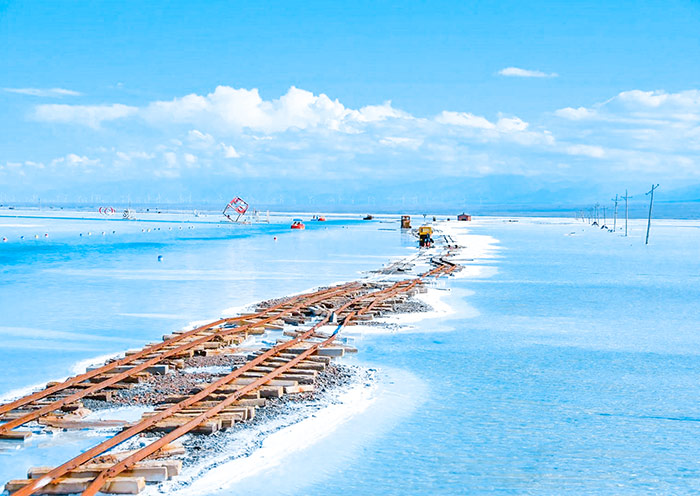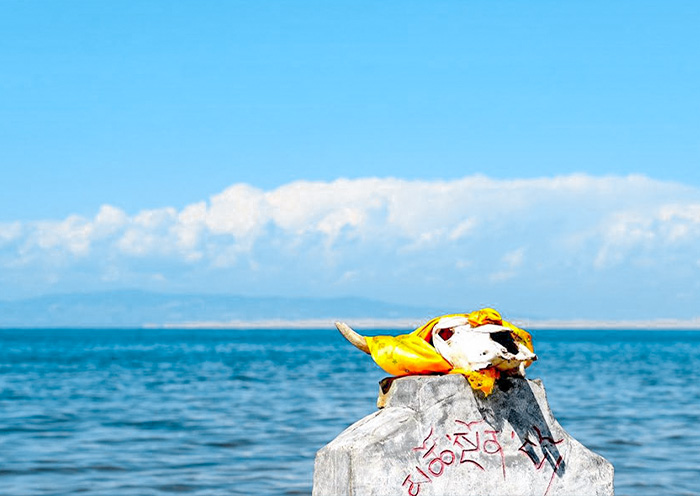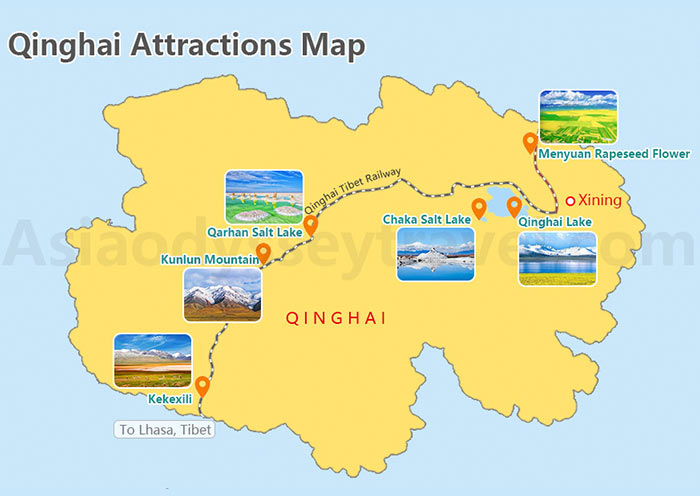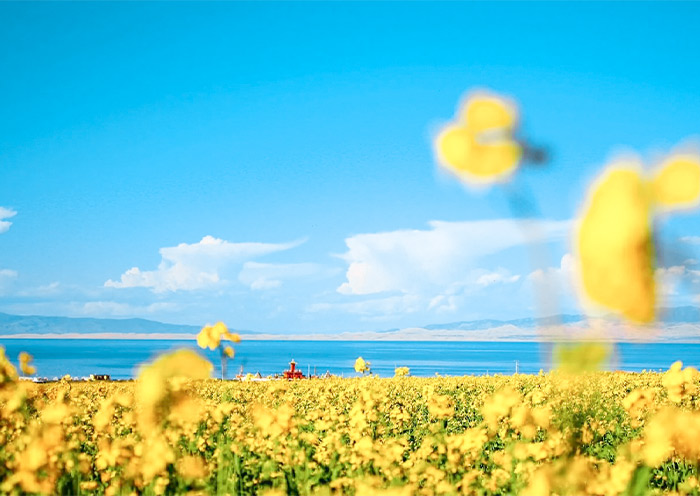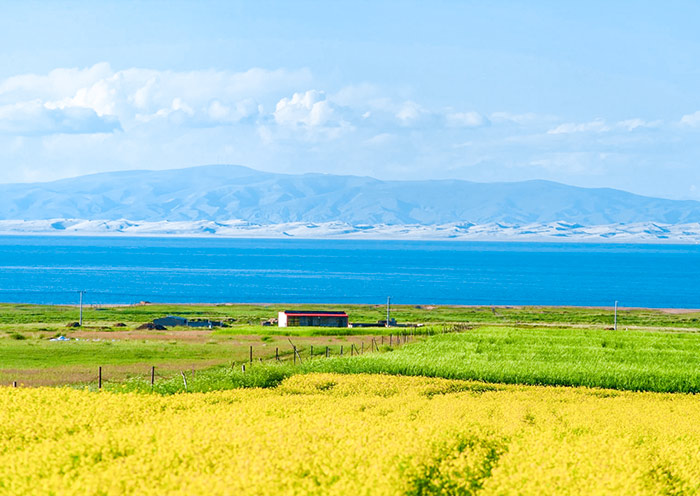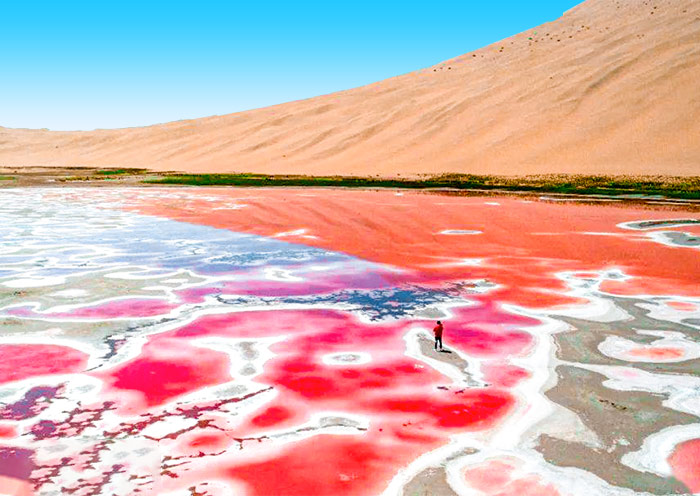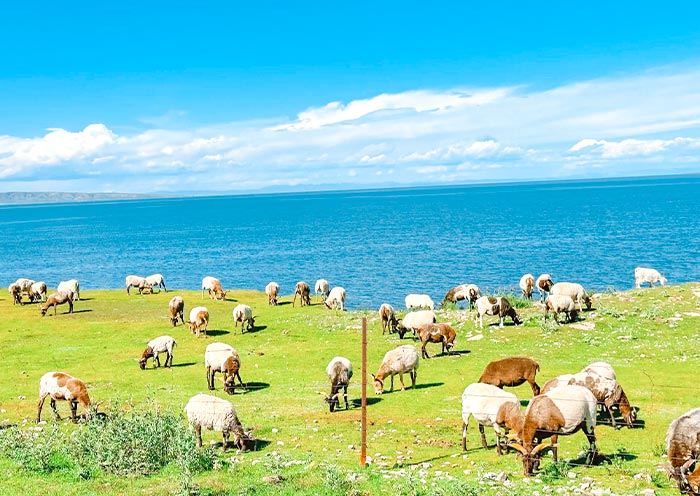Facts about Qinghai
Chinese: 青海 (Qīnghǎi)
Named for: Derived from the name of Qinghai Lake ("blue/green lake")
Location: Northwest China, on the Qinghai-Tibet Plateau, bordered by Gansu, Sichuan, Tibet and Xinjiang
Area: 720,000 km2 (280,000 sq mi)
Population: 5,923,957 (2020)
Climate: A continental climate with cold winters, mild summers, and a significant temperature differences between day and night
Average Elevation: Approximately 3000 m
Religion: The Han Chinese follow Buddhism, Taoism, and Confucianism. The Tibetans practice Tibetan Buddhism or Bon, while the Hui people predominantly follow Islam.
Language: Zhongyuan Mandarin (Central Plains) Chinese, Amdo Tibetan, Monguor, Oirat Mongolian, Salar and Western Yugur
Qinghai Map with Key Attractions
Qinghai, located on the northeastern edge of the Tibetan Plateau in western China, is a region rich in natural beauty, cultural heritage, and historical significance.
Some of the most famous Qinghai's attractions include Qinghai Lake (Kokonor Lake), Ta’er Monastery, Chaka Salt Lake, and the Xining Dongguan Mosque. You can explore this remote region using our detailed Qinghai attractions map, which highlights these must-visit destinations, along with others such as the Qinghai Tibetan Culture Museum and Tibetan Medicine Museum of China.

Add These Attractions to Your Qinghai Tour
Most Qinghai travel packages highlight the region’s iconic scenic spots, but there's so much more to explore beyond the must-see Qinghai attractions.
If you have extra time, consider visiting hidden gems like Kanbula National Park, Menyuan Hui Autonomous County, etc. You can also extend your journey to Gansu and Xinjiang for a deeper Silk Road experience, or embark on the Sky Train to Tibet for a breathtaking adventure!
Qinghai Lake
As China’s largest inland saltwater lake, Qinghai Lake offers stunning views of vast blue waters surrounded by golden fields of rapeseed flowers (in July and August). Popular activities include cycling around the lake, hiking along its shores, birdwatching in May and June, and enjoying beautiful sunrises or sunsets.
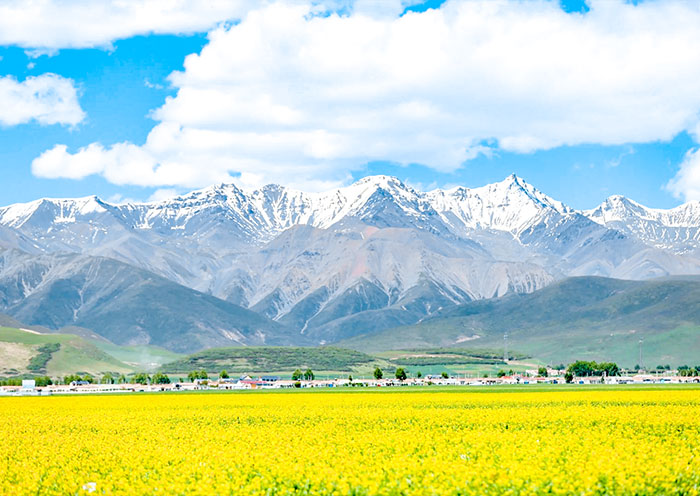
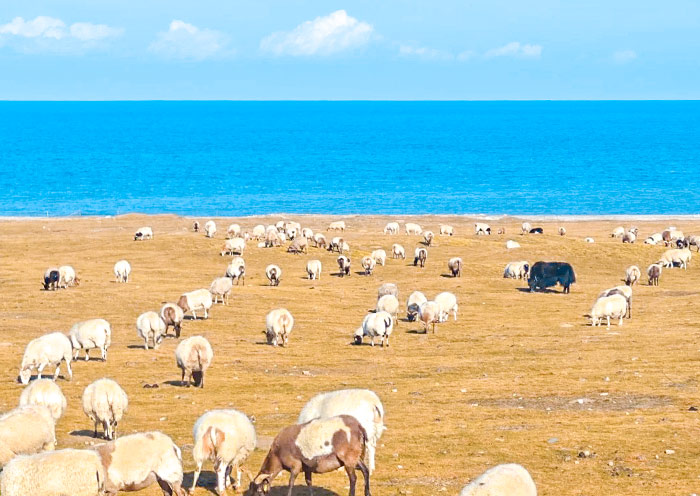
Ta’er Monastery
Ta'er Monastery (Kumbum Monastery) is one of the most important Tibetan Buddhist monasteries in China and the most populous monks outside of Tibet. Founded in 1379, it’s the birthplace of the Gelug sect’s founder, Tsongkhapa.
The monastery is famous for its yak butter sculptures (酥油花), intricate crafts made from yak butter, Buddhist murals, and appliqué thangka (贴花唐卡/堆绣),which are a type of embroidered thangka. Additionally, you can find magnificent Buddha stupas and prayer wheels throughout the site, providing a deep immersion into Tibetan culture and religious practices.
Chaka Salt Lake
Known as the "Mirror of the Sky," Chaka Salt Lake is a must-visit for photography lovers. The crystal-clear lake reflects the sky, creating breathtaking mirror-like images. You can also explore the lake by walking along its salt paths or taking a sightseeing train.
The best time to visit Chaka Salt Lake is during sunny summer days (July to August).
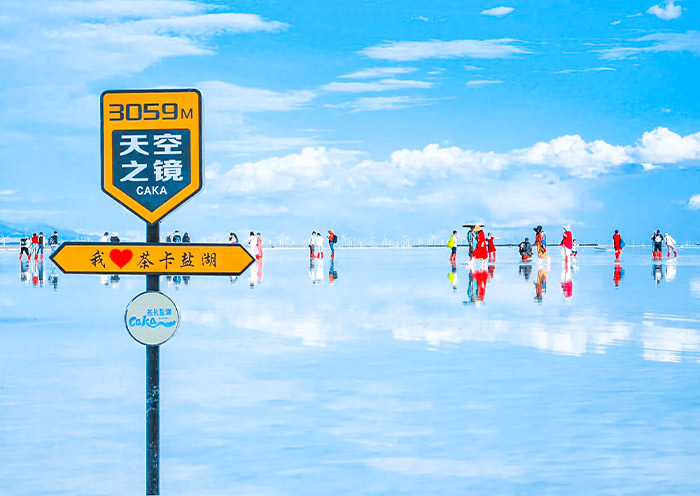

Xining Dongguan Mosque
This mosque, one of the largest in northwest China, is a beautiful blend of Islamic and Chinese architectural styles. A visit to Xining Dongguan Mosque provides insight into the local Hui Muslim culture, and visitors can explore the peaceful courtyard and prayer halls. Fridays see the mosque filled with worshippers, offering a vibrant cultural experience.
Qinghai Tibetan Culture Museum & Tibetan Medicine Museum of China
The Qinghai Tibetan Culture Museum in Xining is a key destination for anyone eager to explore the rich traditions and history of Tibetan culture. Its extensive collection includes ancient manuscripts, traditional clothing, religious relics, and intricate Thangka paintings, offering a comprehensive look at Tibetan life and heritage.
Adjacent to it, the Tibetan Medicine Museum of China highlights the unique medical practices of Tibetan culture. Here, visitors can explore ancient medical texts, traditional remedies, and detailed Thangka illustrations that depict centuries-old Tibetan healing methods.
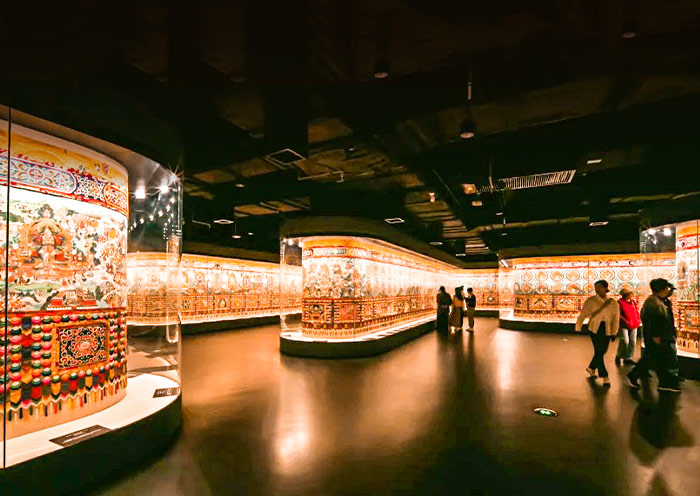
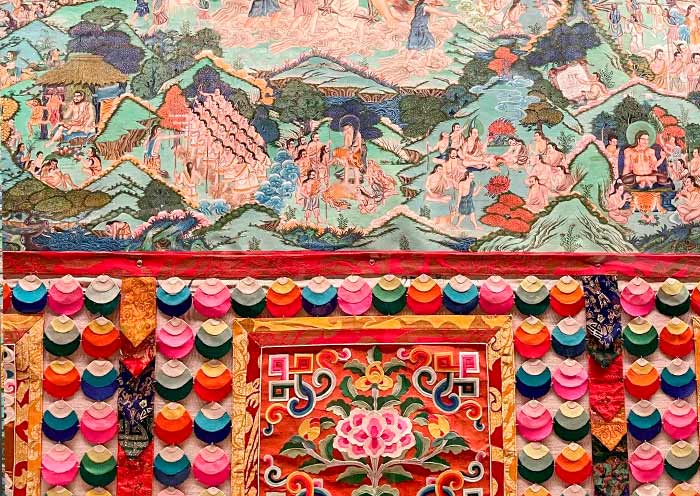
How Long to Stay in Qinghai: Suggest Travel Duration & Itineraries
3-4 days are enough for you to unlock the key Attractions in Qinghai. Here are two itinerary sample of Qinghai tour offered for your reference:
3-Day Qinghai Travel Itinerary
Attractions: Xining Ta'er Monastery, Qinghai Lake (Kokonor Lake), Chaka Salt Lake
Day 1: Arrival in Xining
Arrive in Xining and visit the revered Ta'er Monastery, an important Tibetan Buddhist site renowned for its stunning murals and butter sculptures. In the evening, explore the local night market to sample Qinghai’s famous street food and regional specialties.
Day 2: Xining to Qinghai Lake (Erlangjian Scenic Area)
Travel to the picturesque Qinghai Lake, stopping at Erlangjian Scenic Area (二郎剑风景区) for optional activities like boating, horse riding, or cycling along the shore. In the afternoon, continue the scenic drive to Chaka Town and spend the night there.
Day 3: Chaka Salt Lake to Xining
In the morning, visit Chaka Salt Lake, known as the "Mirror of the Sky." Stroll along the reflective salt flats, and consider a ride on the scenic train (one way) for panoramic views. Afterward, transfer back to Xining for departure.
4-Day Qinghai Travel Itinerary
Attractions: Qinghai Lake, Chaka Salt Lake and Ta'er Monastery, Qinghai Tibetan Culture Museum, Tibetan Medicine Museum of China, and Dongguan Mosque in Xining
Day 1: Arrival in Xining
Arrive in Xining and settle into your accommodation. Spend your evening exploring the local night market, where you can sample a variety of delicious street foods and experience the vibrant atmosphere of this bustling city.
Day 2: Xining – Qinghai Lake – Chaka Town
Depart from Xining and head to Qinghai Lake. Visit the stunning Erlangjian Scenic Area, where you can participate in optional activities such as boating, horse riding, or cycling along the lake's picturesque shoreline. In the afternoon, drive to Chaka Town for an overnight stay.
Day 3: Chaka Town – Chaka Salt Lake – Return to Xining
In the morning, visit Chaka Salt Lake, often referred to as the "Mirror of the Sky" for its breathtaking reflections. Enjoy a ride on the scenic train (one way) to take in the stunning views. After your visit, drive back to Xining, where you can relax or explore more of the city.
Day 4: Xining – Ta'er Monastery & Cultural Sites
On your final day, visit Ta'er Monastery, an important Tibetan Buddhist site known for its beautiful architecture and art. Explore the Qinghai Tibetan Culture Museum & Tibetan Medicine Museum of China to learn about the region's unique traditions. Finally, visit Dongguan Mosque, one of the largest mosques in Xining.
After your cultural tour, transfer to the airport or train station for departure.
Qinghai Weather: Best Time to Enjoy a Qinghai Tour
Qinghai experiences a high-altitude, continental climate, with long winters and cool summers.
The best time to visit Qinghai is from May to October, when the weather is mild, and the landscape is at its most beautiful. July and August are ideal for witnessing the stunning rapeseed flowers around Qinghai Lake. However, this is also peak tourist season.
For fewer crowds, consider traveling in May, June, September, or October. Be prepared for fluctuating temperatures, especially in the evenings, and always pack layers.
Qinghai Transportation: How to Get to Qinghai
Get to Qinghai by Air
Xining, the capital of Qinghai, is easily accessible by air, with Caojiabao International Airport serving as the main hub for travelers. The airport operates over 60 routes, connecting 48 domestic and international cities. Located in Haidong City, about 30 kilometers southeast of downtown Xining, it is just a 30-minute to 1-hour drive from the city center.
Major Chinese cities like Beijing, Shanghai, Guangzhou, Hangzhou, Xi'an, Chengdu, Chongqing, Kunming, and Urumqi all offer flights to Xining. Additionally, travelers from popular Asian cities such as Bangkok, Tokyo, Seoul, Kuala Lumpur, and Siem Reap can fly to Xining Caojiabao International Airport.
Get to Qinghai by Train
Xining is also Qinghai's major rail hub, with Xining Railway Station being the top choice for train travelers. As the starting point of the Qinghai-Tibet Railway, it connects Xining with Lhasa in Tibet, offering scenic and iconic train journeys.
You can reach Xining by bullet train from cities like Xi'an, Lanzhou, Zhangye, Jiayuguan, Dunhuang, Turpan, and Urumqi. Additionally, regular trains run from Lhasa, Golmud, Delingha, Beijing, Chengdu, Chongqing, Taiyuan, and other key destinations.
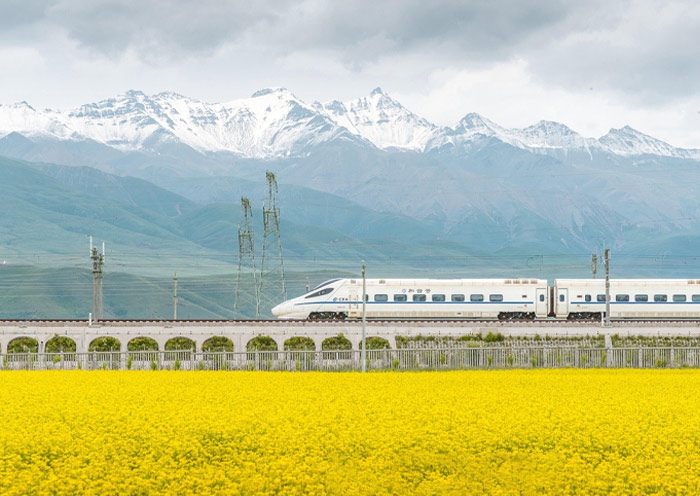
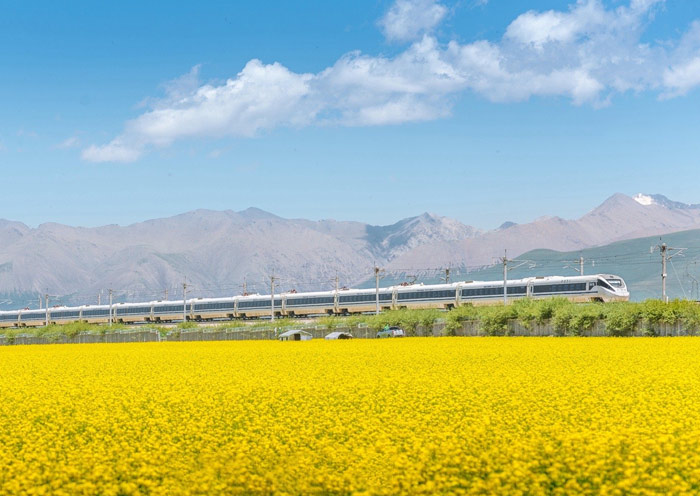
Get Around Qinghai
The most convenient and efficient way to get around Qinghai is by driving. The highways are well-maintained and offer stunning views of the landscape throughout the journey. While there are long-distance buses between major tourist spots, they can be time-consuming and often require additional transfers.
For a hassle-free experience, Asia Odyssey Travel (AOT) is the best option. We provide door-to-door service, picking you up from the airport or train station and driving you to every destination in a safe, clean, and comfortable licensed vehicle.
This allows you to fully focus on your sightseeing and enjoy the trip. Plus, our drivers can make stops along the way for you to take in the breathtaking scenery. Here are some key driving distances and times in Qinghai:
- Xining to Qinghai Lake: about 150 km, 2-2.5 hours' drive
- Xining to Chaka Salt Lake: about 300 km, 3.5-4 hours' drive
- Qinghai Lake to Chaka Salt Lake: about 150 km, 2.5-3 hours' drive
- Xining to Ta’er Monastery: about 28 km, 30 minutes' drive
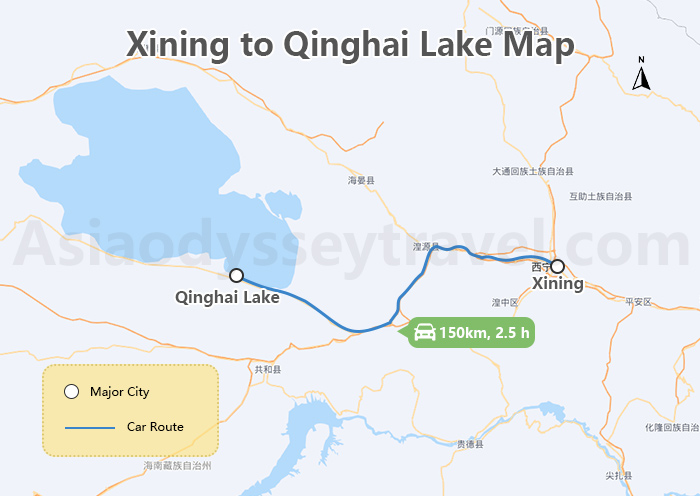
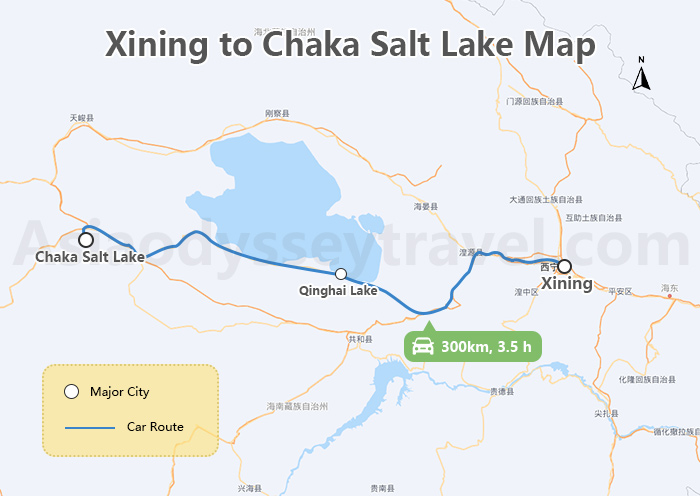
Qinghai Accommodation: Where to Stay in Qinghai
Qinghai has a wide variety of accommodations, ranging from budget-friendly hotels to upscale choices. When selecting accommodation, try to choose areas with convenient transportation and well-developed amenities. For popular scenic areas, it’s wise to book ahead as rooms can fill up quickly.
- Qinghai Lake
The Erlangjian Scenic Area is one of the most popular spots around Qinghai Lake, offering several hotels and guesthouses nearby. Prices vary by season and amenities.
- Chaka Town
Home to Chaka Salt Lake, Chaka Town has a range of hotels and guesthouses, though prices tend to be higher due to its proximity to the lake.
- Xining
As the capital of Qinghai, Xining is well-developed with plenty of accommodation options across different districts.
East District: This is a prime area for visitors, especially around Mojia Street (莫家街商业街), where you’ll find a lively night market. The area is convenient, with an airport bus stop at the central plaza and close proximity to the train station. East District is also near Dongguan Mosque.
South District: Located farther from downtown, South District has more affordable hotels and is a good base for those planning to visit Ta’er Monastery.
West District: A vibrant area with plenty of modern amenities around the Wanda Tangdao (万达唐道) Shopping Center, which offers a variety of dining, entertainment, and nightlife options, including a night market. Hotel prices tend to be higher here, and it’s slightly farther from the train station and airport, with the airport bus taking about 1.5 hours.
North District: This newer area offers modern hotels at generally lower prices than the West District.

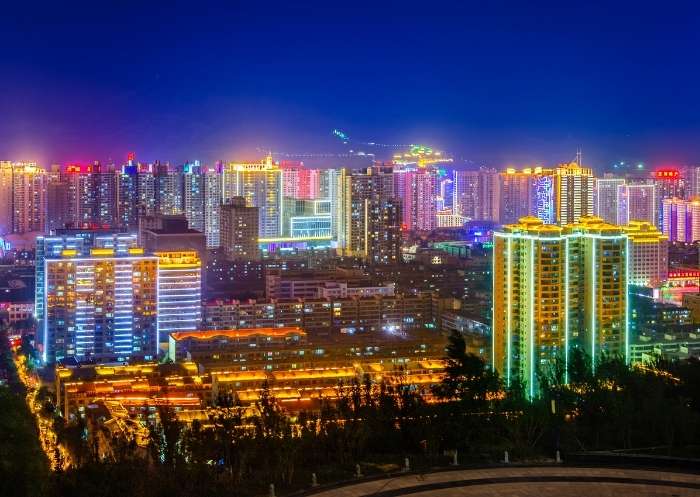
Qinghai Food to Try During Your Qinghai Tour
Qinghai is home to a diverse population, including Han Chinese, Hui people, and Tibetans, and this diversity is reflected in its cuisine. Qinghai food showcases a blend of Han and Hui flavors, while also incorporating elements of Tibetan cuisine from pastoral areas.
The taste of Qinghai cuisine tends to be sour, spicy, salty, and rich, with a texture that is often tender and crispy. The cooking methods are rustic, focusing on roasting, frying, steaming, braising, and boiling, with beef and lamb as the main ingredients.
Some must-try Qinghai dishes include:
Qinghai Hot Pot (青海土火锅)
Located on the Qinghai-Tibet Plateau with its cold climate, Qinghai is known for its abundant beef and lamb, and locals enjoy eating hot pot. The base broth for Qinghai's hot pot is typically made from a clear soup of simmered yak or mutton, with a hint of pickled Chinese cabbage added for flavor.
The hallmark of this hot pot is its simplicity, using minimal seasonings to keep the broth clear and the flavor naturally rich. Common ingredients include yak, mutton, ribbonfish, meatballs, potatoes, tofu, vermicelli, kelp, leafy greens, etc.
Yangchang Noodles (羊肠面)
Yangchang noodles are a traditional cuisine from Xining. This dish features lamb or mutton intestines as the main ingredient, served with hot soup and sliced noodles. Don’t forget to add condiments like spicy chili, soy sauce, vinegar, and celery to enhance the flavor. The blend of aromas makes it an irresistible treat.
Rang Pi (酿皮)
Qinghai's Rang Pi is made from starch and mashed potatoes, which are cooked into crispy cake-like sheets and then sliced into strips. The Rang Pi resembles golden ribbons, releasing a tempting aroma. When paired with chives and chili oil, it offers a refreshing and flavorful taste with a delightful texture.
Qinghai Flatbread (青海甘蓝饼)
Qinghai Flatbread, also known as "Gou Jiao Niao (狗浇尿)", is made by mixing highland barley flour and wheat flour, then pan-fried into thin flatbread. With a golden and tempting color, the pancake has a soft and delicate texture.
It can be enjoyed on its own to savor its original flavor or wrapped around various ingredients like vegetables, eggs, or sausages for a more diverse taste.
Ga Mian Pian (尕面片)
Ga Mian Pian is a signature hand-torn noodle dish from Qinghai Province. Made from wheat flour, water, and salt, the dough is kneaded, left to rest, and then cut into strips before being hand-pinched into small pieces, which is why it’s also called "Pinched Mian Pian or Noodles (揪面片)."
The noodles resemble fingernail-sized pieces and are known for their tender, chewy texture and fresh, fragrant flavor. There are various ways to enjoy Ga Mianpian — it can be boiled, stir-fried, stewed, or mixed, each preparation offering a unique taste experience.
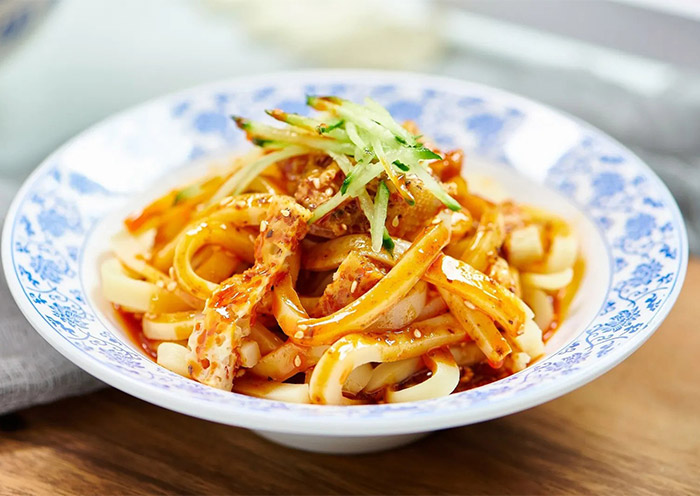
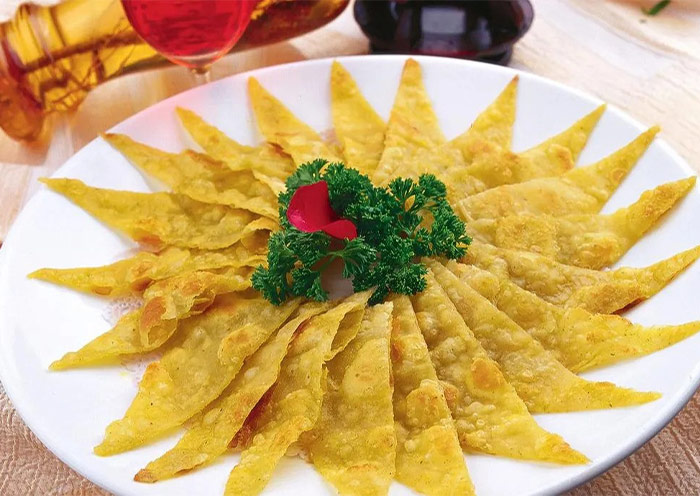
Packing Lists for a Qinghai Tour
Given Qinghai's high altitude and unpredictable weather, packing wisely is crucial. Here’s a guide to ensure you're well-prepared:
- Clothing: Layering is essential. Even in summer, temperatures can drop significantly at night. Bring warm layers, including a windproof jacket and thermal wear for colder months.
- Sun Protection: The high-altitude sun is strong, so pack sunscreen (high SPF), sunglasses, and a wide-brimmed hat to prevent sunburn.
- Altitude Sickness Medication: If you're not used to high altitudes, bring altitude sickness medication. Staying hydrated and pacing yourself will help with acclimatization.
- Motion Sickness Medication: The winding mountain roads in Qinghai can cause discomfort, so bring anti-motion sickness pills if needed.
- Comfort Essentials: The dry climate can be tough on your skin. Be sure to pack moisturizer, lip balm, and plenty of water. Snacks and a reusable water bottle are great for long drives.
Travel to Qinghai with Asia Odyssey Travel (AOT)
For a hassle-free experience, consider booking your Qinghai trip with Asia Odyssey Travel (AOT). We specialize in crafting personalized travel itineraries that cover all the essentials, from transportation and accommodation to guided tours of Qinghai’s most famous attractions. With AOT, you can relax and enjoy the incredible landscapes and cultural heritage that Qinghai has to offer.
Whether you’re exploring the serene beauty of Qinghai Lake or embarking on a grand Silk Road adventure, this Qinghai Tour Plan Guide will help you plan the perfect trip to one of China’s most awe-inspiring destinations!



